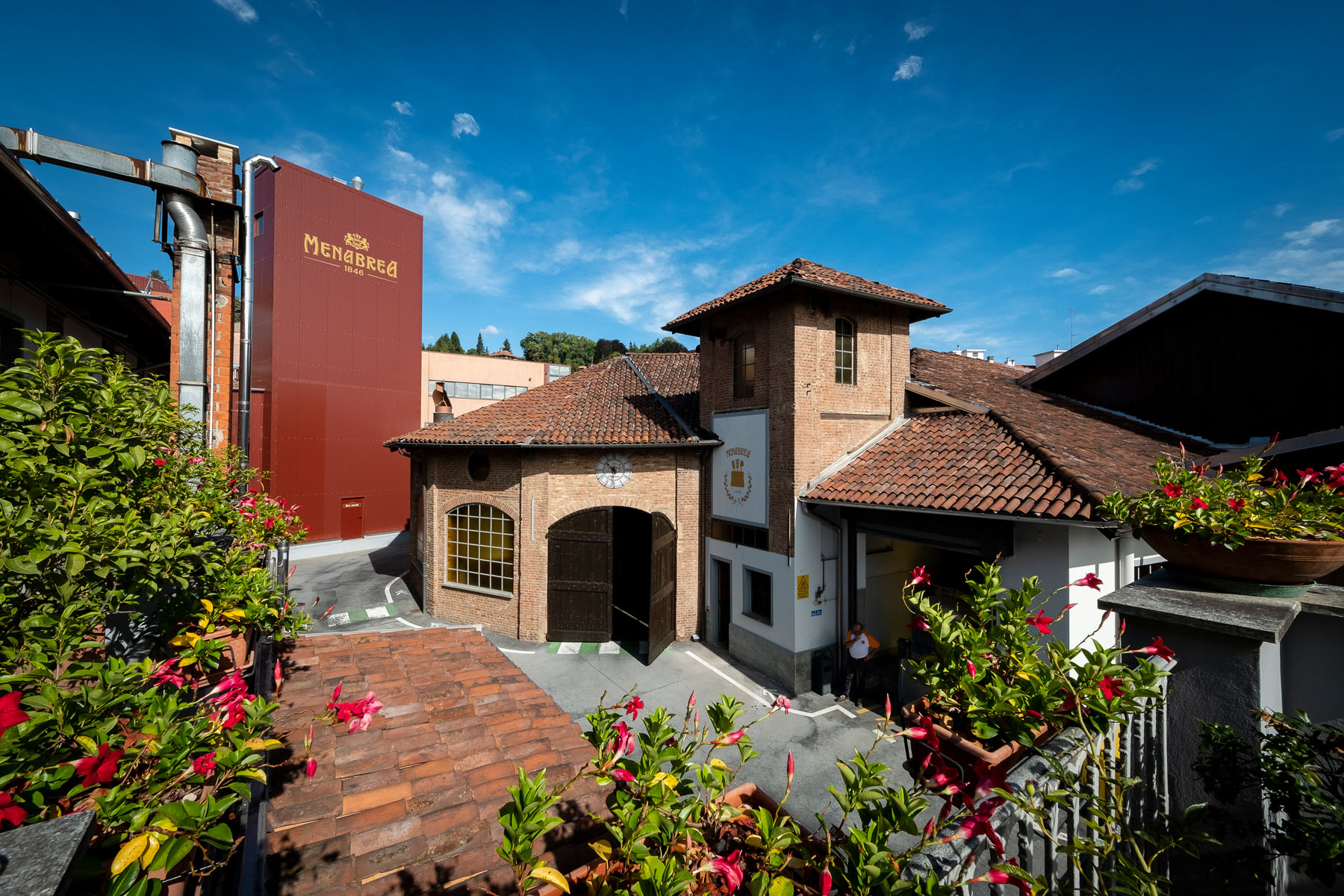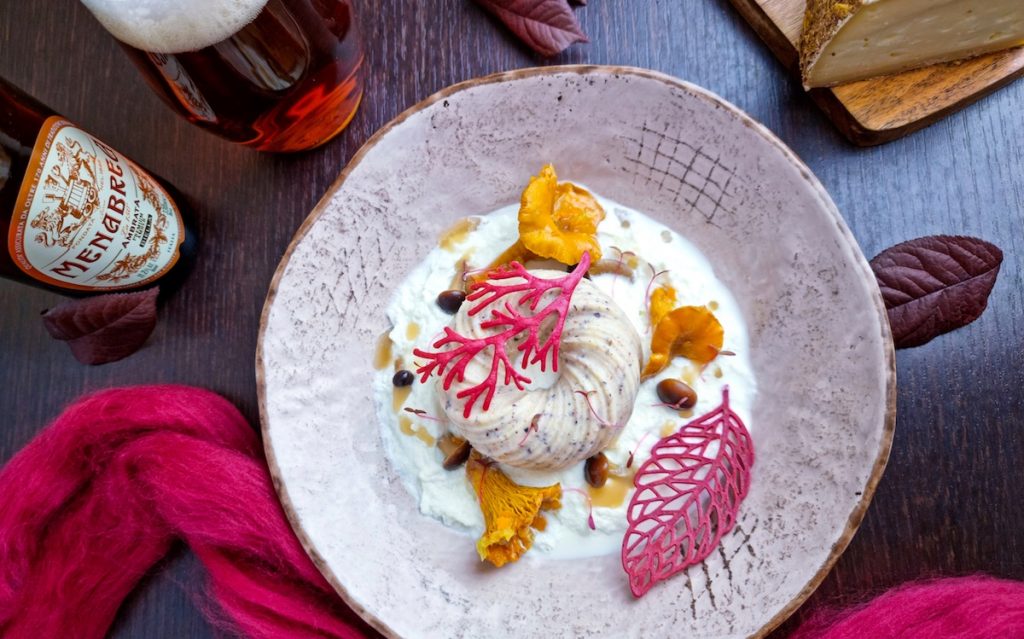Via Live In Italy Magazine. Article and recipe by LORENZO DIAMANTINI.

Capturing Biella Through Menabreaand Polenta Concia
Nov 16, 2021
We could say that life is like a nice cold glass of beer: a short eternity.
A PARADISE BETWEEN NATURE AND ARTIFICE
Is it better to live longer or more intensely? To answer this Hamletic question, I am taking you to Biella, home of Birra Menabrea. This Piedmontese city intensely lives out its ancient industrial tradition and boasts the rich longevity of its green and pure waters flowing from a horizon crowned by Alpine peaks.
BIELLA
In addition to the natural wonders, the area holds true religious, cultural and artistic treasures. It is a place of marked spirituality and of devotion to work and culture, surrounded by architectural beauties and a precious natural context. Here, water is a source of life in all senses and a fil rouge (common thread) that tells the story of the land.
The abundant natural water supply has always been the real engine of local industry, so much so that it is used to produce the historic beer, Menabrea. It’s also historic because this brewery is the oldest in Italy and still active. Menabrea was founded with the intent to make the most of the purest water that flows from the mountains of Oropa, once used mainly by the flourishing wool and textile industry.
MENABREA HISTORY
With more than 170 years of activity, Birra Menabrea has undoubtedly contributed to the history of beer in Italy and right from the very beginning. They made a mark with the application of the bottom fermentation technique, not very widespread at the time, and the use of excellent quality raw materials. First and foremost, the water from the Biella springs, which has characterized this beer from the very beginning, has decreed its success and fame on an international level.

The history of the brewery is what fascinated me about Menabrea, which still maintains its original headquarters in the historic center of Biella. Still intact is the precious synergy with the territory that has seen an entire dynasty of master brewers at work in a unique context: between innovation and tradition.
CASA MENABREA, MUSEUM OF BEER
Next to the brewery is Casa Menabrea, the Museum of Beer which illustrates its production process, the history of the company, the family that has led it for five generations. The museum also has an area dedicated to another historic company of the territory: Botalla, masters of that art of cheese-making devoted to the typicality and high quality of cheeses.
MEBO
MeBo is the acronym that unites these two neighboring companies in one cheese: Sbirro. Sbirro is a Toma strictly made from Biella milk of Pezzata Rossa di Oropa and Bruna Alpina, and is produced and aged with Menabrea beer. The cheese features an intense flavor and an original and fragrant aroma that gives you a glimpse into the gastronomic tradition of Biella with its ancient origins and strong flavors.
This cheese and Menabrea beer are the protagonists of my dish that has its roots in the traditional Polenta Concia, or ‘Polenta Cunscia’, typical of Biella. This polenta sees the addition of cheese, which has always been abundant in these areas, as well as butter, which is melted here, to accompany this delight.
A PERFECT PAIRING
The polenta becomes a Savarin with an artistic shape that recalls a ball of wool and rests on a foam of cheese that evokes beer foam. The mushrooms are deglazed with Menabrea lager beer, balanced with a moderate bitterness contrasted by the sweetness of a beet shortbread, accompanied by the warm aromaticity of beurre noisette and decorated with beet sprouts.
All is paired with Menabrea Ambrata (amber): a Märzen style beer that is characterized by a sweet aroma of toasted malt and cane sugar. Its robust body is ideal for this consistent but refined dish in which it finds a logical affinity of flavors and fragrances. It enhances the ingredients and tells the story of a city, the capital of wool and creativity, where art and craftsmanship meet and adapt to the changing seasons spreading beauty and emotions.
A “Third Paradise” as the Biella born artist Pistoletto would define it:
Where the connection between artifice and nature finds its balance.
And perhaps here is the answer to our question: to live intensely in order to make a quality product is not the secret to living longer, but the key to living forever precisely through what we create. It allows us to give a sense to being and to time.

POLENTA CONCIA AND MENABREA
INGREDIENTS
For the polenta:
- Bramata corn flour 500g
- Toma cheese 200g, cubed
- Fontina cheese 200g, cubed
- Water 2L
- Extra virgin olive oil to taste
- Fine salt & black pepper to taste
For the beet shortbread:
- Flour 00 170g
- Beet flour 80g
- Cold butter 125g
- Eggs 50g
- Coarse salt 5g
- Milk to taste
For the mushrooms in beer:
- Chanterelle and honey mushrooms 600g
- 1 Carrot, chopped
- 1 Onion, chopped
- 1 Celery, chopped
- Extra virgin olive oil q.b.
- Light beer 200ml (Menabrea bionda)
- Fine salt & black pepper to taste
For the Beurre Noisette:
- Butter 200g
For the Cheese Mousse:
- Toma cheese 200g, cubed
- Whole milk 150 ml, 300 ml
- Whipping cream 300 ml
- Egg whites 125g
- Salt to taste
METHOD
For the polenta:
Place a thick-bottomed steel pan on the stove, pour in the water and heat it up. When it comes close to boiling add the salt, and pour in the flour, stirring with a wooden spoon.
Keep cooking at a high temperature, stirring quickly, and add the olive oil to avoid the formation of lumps. Continue cooking for 50 minutes over low heat without stopping stirring to avoid polenta sticking to the bottom.
10 minutes before the end of the cooking time, add salt and the chopped cheeses and stir to melt them.
When the polenta is ready and the cheeses are well melted, pour it into the molds and let it rest.
For the beet shortcrust pastry:
Pour the flour into a mixer with steel blades. Add the cold butter, the coarse salt and the egg.
Operate the mixer until the mixture is crumbly. Add the milk, a little at a time until the mixture is smooth and semi-liquid.
Spread the mixture on leaf and branch molds and bake in a static oven at 180° for about five minutes.
For the mushrooms in beer:
Prepare the mushrooms, clean the chiodini and galletti.
In a saucepan, pour two tablespoons of oil and add the carrot, onion, and celery. Sauté and add the mushrooms.
Season with salt and pepper and then add the beer and cover the saucepan with the lid. Cook until the reduction of the liquid.
For the beurre noisette:
Melt the butter over very low heat. Continue cooking, stirring to prevent it from burning – the butter will make larger and larger bubbles as you raise the temperature.
When it stops sizzling and bubbling and has a deep golden color, remove from heat, strain through a sieve and set aside.
Prepare the cheese mousse:
Heat the milk to a boil and melt the cheese over low heat. When cheese is melted, remove from heat and add the liquid cream. Stir and let the mixture sit for about 10 minutes.
Take the cheese, add the egg whites, season and strain. Fill the siphon (500 ml) according to the instructions and shake.
Plate the dish:
Sprinkle the mousse on the plate, lay the warmed polenta on top, add the mushrooms and drizzle everything with the beurre noisette. Decorate with the beet shortbread and amaranth sprouts.
Enjoy with a Menabrea Ambrata. Buon appetito!

MENABREA AMBRATA
Roasted malts add both color and body to this beer and also an enhanced, more robust and complex nose. This beer has a golden-amber color with bronze undertones. It has a rounded, robust, slightly toffee/caramel flavor and nose but has maintained a level of drinkability not usually found in amber beers.
5.0% ABV

MENABREA BIONDA
A classic blonde lager beer produced using Menabrea’s own yeast. Pure mountain water from the Alps combines with selected barley malt and maize (corn) before adding Hallertau Magnum hops. The addition of maize gives a lightness to the beer both in terms of color and taste and also adds a hint of sweetness which balances the bitterness from the Hallertau hops.
A beer with balanced bitterness, a floral fruity nose and a delicate pale-golden color.
4.8% ABV
